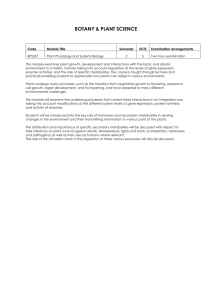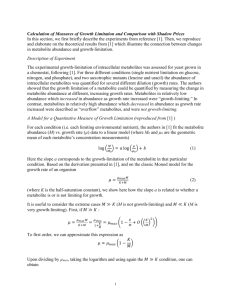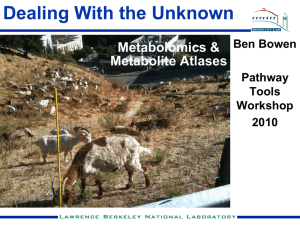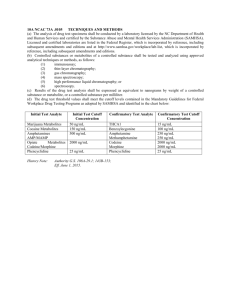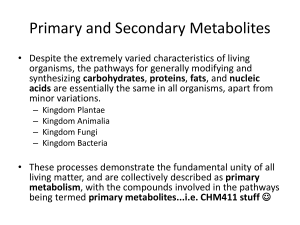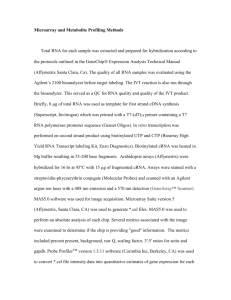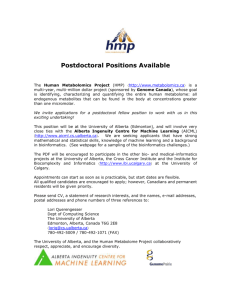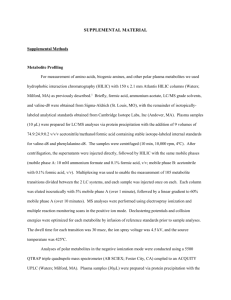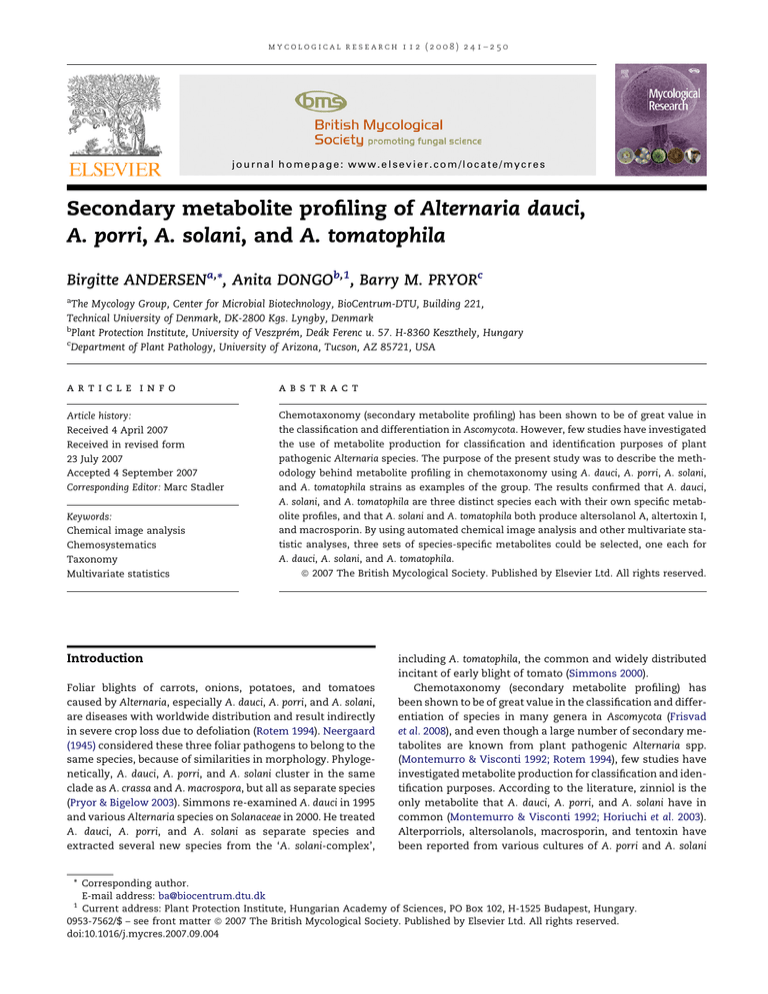
mycological research 112 (2008) 241–250
journal homepage: www.elsevier.com/locate/mycres
Secondary metabolite profiling of Alternaria dauci,
A. porri, A. solani, and A. tomatophila
Birgitte ANDERSENa,*, Anita DONGOb,1, Barry M. PRYORc
a
The Mycology Group, Center for Microbial Biotechnology, BioCentrum-DTU, Building 221,
Technical University of Denmark, DK-2800 Kgs. Lyngby, Denmark
b
Plant Protection Institute, University of Veszprém, Deák Ferenc u. 57. H-8360 Keszthely, Hungary
c
Department of Plant Pathology, University of Arizona, Tucson, AZ 85721, USA
article info
abstract
Article history:
Chemotaxonomy (secondary metabolite profiling) has been shown to be of great value in
Received 4 April 2007
the classification and differentiation in Ascomycota. However, few studies have investigated
Received in revised form
the use of metabolite production for classification and identification purposes of plant
23 July 2007
pathogenic Alternaria species. The purpose of the present study was to describe the meth-
Accepted 4 September 2007
odology behind metabolite profiling in chemotaxonomy using A. dauci, A. porri, A. solani,
Corresponding Editor: Marc Stadler
and A. tomatophila strains as examples of the group. The results confirmed that A. dauci,
A. solani, and A. tomatophila are three distinct species each with their own specific metab-
Keywords:
olite profiles, and that A. solani and A. tomatophila both produce altersolanol A, altertoxin I,
Chemical image analysis
and macrosporin. By using automated chemical image analysis and other multivariate sta-
Chemosystematics
tistic analyses, three sets of species-specific metabolites could be selected, one each for
Taxonomy
A. dauci, A. solani, and A. tomatophila.
Multivariate statistics
ª 2007 The British Mycological Society. Published by Elsevier Ltd. All rights reserved.
Introduction
Foliar blights of carrots, onions, potatoes, and tomatoes
caused by Alternaria, especially A. dauci, A. porri, and A. solani,
are diseases with worldwide distribution and result indirectly
in severe crop loss due to defoliation (Rotem 1994). Neergaard
(1945) considered these three foliar pathogens to belong to the
same species, because of similarities in morphology. Phylogenetically, A. dauci, A. porri, and A. solani cluster in the same
clade as A. crassa and A. macrospora, but all as separate species
(Pryor & Bigelow 2003). Simmons re-examined A. dauci in 1995
and various Alternaria species on Solanaceae in 2000. He treated
A. dauci, A. porri, and A. solani as separate species and
extracted several new species from the ‘A. solani-complex’,
including A. tomatophila, the common and widely distributed
incitant of early blight of tomato (Simmons 2000).
Chemotaxonomy (secondary metabolite profiling) has
been shown to be of great value in the classification and differentiation of species in many genera in Ascomycota (Frisvad
et al. 2008), and even though a large number of secondary metabolites are known from plant pathogenic Alternaria spp.
(Montemurro & Visconti 1992; Rotem 1994), few studies have
investigated metabolite production for classification and identification purposes. According to the literature, zinniol is the
only metabolite that A. dauci, A. porri, and A. solani have in
common (Montemurro & Visconti 1992; Horiuchi et al. 2003).
Alterporriols, altersolanols, macrosporin, and tentoxin have
been reported from various cultures of A. porri and A. solani
* Corresponding author.
E-mail address: ba@biocentrum.dtu.dk
1
Current address: Plant Protection Institute, Hungarian Academy of Sciences, PO Box 102, H-1525 Budapest, Hungary.
0953-7562/$ – see front matter ª 2007 The British Mycological Society. Published by Elsevier Ltd. All rights reserved.
doi:10.1016/j.mycres.2007.09.004
242
(Suemitsu et al. 1990a, b, 1992; Montemurro & Visconti 1992).
Alternariol monomethyl ether has been reported from A.
dauci, erythroglaucin and other anthraquinones from
A. porri, and alternaric acid, alternariol, solanapyrones and
zinnolide from A. solani (Montemurro & Visconti 1992).
The main purpose of this study was to describe the methodology behind metabolite profiling in chemotaxonomy using
A. dauci, A. porri, A. solani, and A. tomatophila strains as examples. One objective was to examine the chemical diversity of
the four aforementioned Alternaria species and compare metabolite profiles with the currently accepted classification. A
second objective was to suggest species-specific metabolites
that could be adopted as chemotaxonomic markers in taxon
identification.
Materials and methods
Fungal strains, growth media, and conditions
Fifty-six fungal strains belonging to the genus Alternaria were
used. The strains were first inoculated on potato carrot agar
(PCA) (Simmons 1992) and grown under standardized conditions (Andersen et al. 2005). In brief, the unsealed 9 cm plates
were incubated in one layer for 7 d at 23 C under an alternating light/dark cycle consisting of 8 h of cool-white fluorescent
daylight and 16 h darkness. Each strain was then inoculated
onto dichloran–Rose Bengal–yeast extract–sucrose agar
(DRYES) (Frisvad 1983) as three-point inoculations and onto
another PCA for confirmation of identity. After inoculation,
the DRYES plates were packed in perforated plastic bags and
incubated for 14 d in the dark at 25 C. The PCA cultures
were incubated as mentioned above and examined morphologically after 7 d according to Simmons (1995, 2000). If sporulation was unsatisfactory, the plates were scarified and
incubated longer. The original and confirmed identity, identification number, host plant, and geographic origin of all
strains are presented in Table 1. All strains are available
from the authors’ private collections and the IBT collection
at BioCentrum-DTU.
Metabolite extraction procedure
Metabolite extractions were performed on the 14-d-old DRYES
cultures. The extraction protocol used was a micro-scale extraction method modified for Alternaria metabolites (Andersen et al.
2005). In brief, three 6 mm agar plugs were cut from the centre of
the three colonies and the nine plugs were placed in a 2 ml
screw-top vial. The plugs were extracted with 1 ml ethyl acetate
containing 1 % formic acid (v/v) in ultrasound for 60 min in
a Branson 3210 water-bath (Ultrasonics Corporation, Danbury,
CT). The extract was transferred to a clean 2 ml vial, evaporated
to dryness in a rotary vacuum concentrator (Christ, Gefriertrocknungsanlagen, Osterode am Harz), re-dissolved ultrasonically in 400 ml methanol, and filtered through a 0.45 mm filter
(National Scientific Company, Rockwood, TN) into a clean 2 ml
vial prior to hplc analysis. The experiment was repeated once
with all strains, and for strains with low metabolite production,
a third time with twice the number of plugs.
B. Andersen et al.
hplc
UV–visible
analysis
The hplc analyses were performed on a HP-1100 high-performance liquid chromatograph (Agilent, Waldbronn) equipped
with an auto-sampler injecting 3 ml sample1 and a diode
array detector collecting 2 UV–visible (UV–vis) spectra s1 from
200–600 nm. Separations were done on a 100 2 mm Luna
3 m C18(2) 100 Å column (Phenomenex, Torrance, CA) with
a 4 2 mm C18(2) guard column (Phenomenex). The column
temperature was 40 C. The mobile phase consisted of a linear
gradient starting at 85 % water and 15 % acetonitrile reaching
100 % acetonitrile in 20 min. One hundred percent acetonitrile
was maintained for 5 min. Thereafter, the gradient was
returned to 15 % acetonitrile in 3 min and allowed to equilibrate for 5 min before the next analysis. Both eluents contained
50 ppm trifluoroacetic acid. The flow rate was 0.4 ml min1. A
homologous series of alkylphenones was analysed as external
retention time references and used to calculate a bracketed RI
for each detected peak (Frisvad & Thrane 1987). Origin and
preparation of fungal standards, such as altenuene, alternarials, altersolanol A, altertoxin I, erythroglaucin, tentoxin, and
tenuazonic acid, are given in Nielsen & Smedsgaard (2003).
All solvents were hplc grade, chemicals were analytical grade,
and the water was double distilled.
Data treatment
A flow sheet of the various steps from automated and manual
analyses of the hplc data to the suggestion of species-specific
metabolites is shown in Fig 1. The raw hplc data files were first
subjected to an automated chemical image analysis (CIA)
(Hansen 2003) and the resulting dendrogram evaluated in respect to original fungal identification and chemical clustering.
In parallel: (1) the identity of the strains was checked by
microscopic methods and (2) a full manual metabolite matrix
was made containing fungal identities and all recognizable
peaks/UV–vis spectra from all hplc chromatograms. Strains
whose identity could not be confirmed and strains that did
not cluster with the main body of strains with the same ID
in the CIA dendrogram were excluded before the matrix was
subjected to partial least squares regression PLS-R. Based on
the resulting loadings plot, the reduced manual metabolite
matrix was constructed and the excluded strains were reintroduced. The new matrix was then subjected to a cluster
analysis and after evaluation of the dendrogram, speciesspecific metabolites were manually selected.
Chemical Image Analysis (CIA)
The raw hplc data files, which are quantitative twodimensional matrices (x-axis: time, y-axis: wavelength, value
in matrix: UV–vis absorbance), were transferred from the hplc
to a standard PC and analysed by an in-house written CIA
program (Hansen 2003). No manipulations or peak selections
were made before processing. Each hplc file was processed
first by a log10 scaling (to account for concentration differences among extracts), then a baseline correction and finally
an alignment (to account for drift in baseline and retention
time among identical metabolites in different runs) (Hansen
2003). Each hplc file was then compared with the other 55
Metabolite profiling of Alternaria
243
Table 1 – Alternaria strains used in the study
Identification
confirmedb
Host plant
Collection no.
Original
identificationa
AD 113
AD 180
AD 181
AD 183
AD 185
AD 188
AD 189
BA 1489
BA 1491
BA 1492
BMP 155
BMP 156
BMP 157
BMP 158
BMP 159
BMP 160
BMP 161
BMP 163
BMP 164
BMP 165
BMP 167
BMP 168
BMP 171
AD 186
BA 1451
BA 1545
BA 1548
BA 1553
BA 1557
BMP 178
AD 155
AD 187
Alternaria dauci
A. dauci
A. dauci
A. dauci
A. dauci
A. dauci
A. dauci
A. dauci R
A. dauci R
A. dauci R
A. dauci
A. dauci
A. dauci
A. dauci
A. dauci
A. dauci
A. dauci
A. dauci
A. dauci
A. dauci
A. dauci
A. dauci
A. dauci
A. porri
A. porri R
A. porri
A. cfr porri
A. porri
A. porri
A. porri
A. solani
A. solani
þ
þ
þ
þ
þ
þ
þ
þ
þ
þ
þ
þ
þ
þ
þ
þ
þ
þ
þ
þ
þ
þ
þ
NS
þ
þ
A. cfr porri
þ
þ
A. cfr porri
A. cfr solani
NS
Daucus carota
D. carota
D. carota
D. carota
D. carota
D. carota
D. carota
D. carota
D. carota
D. carota
D. carota
D. carota
D. carota
D. carota
D. carota
D. carota
D. carota
D. carota
D. carota
D. carota
D. carota
D. carota
D. carota
Allium cepa
A. cepa
A. cepa
A. ascalonicum
A. cepa
A. cepa
A. ampeloprasum
Solanum tuberosum
S. aviculare
BA 1444
BA 1546
BA 1552
BA 1555
BA 1558
BMP 181
BMP 182
BMP 183
BMP 185
BMP 186
A. solani R
A. solani
A. solani
A. solani
A. solani
A. solani
A. solani
A. solani
A. solani
A. solani
þ
þ
þ
þ
þ
þ
þ
þ
A. cfr solani
þ
S. tuberosum
S. tuberosum
S. tuberosum
S. tuberosum
S. tuberosum
Lycopersicon esculentum
S. tuberosum
S. nigrum
BMP 187
BA 1443
BA 1523
BA 1524
BA 1525
BA 1526
BA 1527
BA 1528
BA 1541
BA 1542
BA 1544
BA 1549
BA 1550
BA 1554
A. solani
A. tomatophila R
A. tomatophila
A. tomatophila
A. tomatophila
A. tomatophila
A. tomatophila
A. tomatophila
A. cfr tomatophila
A. cfr tomatophila
A. tomatophila T
A. cfr tomatophila
A. cfr tomatophila
A. cfr tomatophila
NS
þ
þ
þ
þ
þ
þ
þ
þ
þ
þ
þ
þ
þ
L. esculentum
L. esculentum
L. esculentum
L. esculentum
L. esculentum
L. esculentum
L. esculentum
L. esculentum
L. esculentum
L. esculentum
L. esculentum
L. esculentum
L. esculentum
L. esculentum
Substratum and origin
Carrot, -, NZ
Carrot, leaf, Germany
Carrot, leaf, Germany
Carrot, seed, NL
Carrot, seed, Carrot, leaf, Hungary
Carrot, leaf, Hungary
Carrot, seed, CA, USA
Carrot, leaf, NZ
Carrot, seed, CA, USA
Carrot, seed, Carrot, leaf, CA, USA
Carrot, leaf, CA, USA
Carrot, seed, Carrot, seed, Carrot, seed, Carrot, seed, Carrot, seed, Carrot, seed, Carrot, leaf, CA, USA
Carrot, leaf, FL, USA
Carrot, seed, Carrot, -, CA, USA
Onion, seed, DK
Onion, leaf, NY, USA
Onion, -, NY, USA
Shallot, -, NZ
Onion, - , Mexico
Onion, -, NY, USA
Leek, leaf, Australia
Potato, leaf, Hungary
New Zealand nightshade,
leaf, DK
Potato, leaf, WA, USA
Potato, -, NY, USA
Potato, -, CA, USA
Potato, -, NZ
Potato, -, NY, USA
Tomato, fruit, CA, USA
-, -, CA, USA
-, -, CA, USA
Potato, tuber, CA, USA
Black nightshade,
leaf, CA, USA
Tomato, -, Mexico
Tomato, leaf, IN, USA
Tomato, leaf, Australia
Tomato, leaf, Australia
Tomato, stem, FL, USA
Tomato, leaf, NZ
Tomato, leaf, Venezuela
Tomato, -, PA, USA
Tomato, leaf, IN, USA
Tomato, leaf, IN, USA
Tomato, leaf, IN, USA
Tomato, leaf, IN, USA
Tomato, leaf, IN, USA
Tomato, fruit, IN, USA
No. in other
collections
CBS 101592
CBS 106.48
EGS-46-006
EGS-46-152
EGS-47-131
ATCC 36613
CBS 114.38
EGS-48-147
EGS-48-152
EGS-46-052
EGS-49-065
EGS-48-153
CBS 110.41
EGS-44-098
EGS-46-125
EGS-45-020
EGS-45-053
EGS-46-133
ATCC 58177
EGS-44-074
EGS-44-024
EGS-44-036
EGS-44-046
EGS-46-161
EGS-48-026
EGS-50-065
EGS-44-073
EGS-44-169
EGS-42-156
EGS-44-170
EGS-44-072
EGS-46-012
a Original identity given by the authors (A.D. & B.M.P.). B.A. strains received from Emory G. Simmons. R, representative strain for the species;
T, ex-type strain for the species.
b Confirmed at BioCentrum-DTU. þ, identification confirmed compared to representative and ex-type strains; cfr, deviated morphologically
compared to the representative strains and was reintroduced in the final analysis; NS, no sporulation and was removed from final analyses.
244
HPLC data
B. Andersen et al.
CIA
Morphology data
Dendrogram 1
Full manual
metabolite matrix
PLS-R
analysis
Fungal
ID
Loadings
plot
Reduced manual
metabolite matrix
Dendrogram 2
Cluster
analysis
Species-specific
metabolites
Fig 1 – Flowchart of the procedures, decisions, and analyses
leading to the selection of species-specific metabolites.
hplc files, pair-wise, using an algorithm described by Hansen
(2003) giving a similarity value for each pair, which was
entered into a new matrix. The resulting 56 56 similarity
matrix was then used to calculate a dendrogram using
WARD clustering method.
chromatograms (hplc files) of raw fungal extracts that contained compounds from the growth media (e.g. chloramphenicol and dichloran), impurities from extraction solvents,
fungal-specific (e.g. ergosterol), species-specific, and strainspecific metabolites. The dendrogram shows two main clusters, A and B. Cluster A contained A. solani and A. tomatophila
strains and cluster B contained A. dauci and A. porri strains.
Cluster A consisted of three minor clusters: one A. solani cluster (A1), which included one A. porri strain (BA 1553), but not
the representative strain of A. solani (BA 1444); one miscellaneous cluster (A2) with A. dauci (BMP 163), two A. solani strains
(AD 155 and AD 187), two A. porri strains (BA 1548 and AD 186)
strains and the representative strain of A. solani (BA 1444); and
one A. tomatophila cluster (A3), including one A. solani strain
(BMP 187). Cluster B also contained three clusters: one A. dauci
cluster (B1) and one A. porri cluster (B2) with a cluster (B3) of
three A. dauci strains (AD 185, AD 113, and BMP 165). Construction of the full manual metabolite matrix showed that the extracts of strains in the miscellaneous cluster (A2) and the
small A. dauci cluster (B3) had between 60 and 85 % fewer metabolites compared with extracts in the nearest sister clusters.
Repeated experiments (growth, extraction, and hplc analysis)
with these strains resulted in the same low metabolite
production.
Partial Least Squares Regression (PLS-R)
Partial Least Squares Regression (PLS-R)
The binary matrix was made manually by scoring each metabolite as present or absent from the printed chromatograms
and subjected to multivariate statistics using The Unscrambler version 9.2 (CAMO ASA, Oslo). This full manual metabolite
matrix consisted of 64 x-variables (known and unknown metabolites) and four y-variables (four species names) for the
43 objects (fungal strains with confirmed ID and clustering
according to ID). The matrix was analysed using PLS-R, which
relates the variations in response variables ( y-matrix) to the
variations of several predictors (x-matrix) (Wold et al. 2001).
By plotting the PLS components one can view main associations between x-variables (metabolites) and y-variables (strain
ID), and also interrelationships within x- and y-data.
Cluster analyses
The full manual metabolite matrix was reduced according to
the PLS-R result and contained consistently produced metabolites with both known and unknown chemical structures.
The binary, reduced metabolite matrix, consisting of 53
strains and 34 species-specific metabolites, was subjected to
cluster analysis using NTSYS-pc version 2.11N (Exeter Software, Setauket, NY) without standardization using Yule (Y)
as correlation coefficient and UPGMA as clustering method.
The matrix was also analysed by simple matching (SM) and
Jaccard (J) similarity coefficients in NTSYS.
Results
Chemical Image Analysis (CIA)
The result of the automated and unbiased CIA of 56 Alternaria
extracts is shown in Fig 2. The analysis is based on unedited
Before a PLS-R could be performed, a consensus between
chemical and morphological data was necessary. The identity
of all strains was confirmed by comparison with the type or
representative strains of each species (see Table 1). Morphological re-examination lead to the permanent exclusion of
Alternaria porri (AD 186) and A. solani (AD 187 and BMP 187)
from any further analyses, because it was not possible to induce sporulation in these strains again and thereby confirm
their identity. A. porri (BA 1548 and BMP 178) and A. solani
(AD 155 and BMP 185) were temporarily omitted, because of
morphological discrepancies when compared with representative strains. Examination of chemical data lead to the temporary omission of A. dauci (AD 185, AD 113, BMP 163, and
BMP 165), A. porri (BA 1553), and A. solani (BA 1444), because
they either clustered in the miscellaneous cluster (A2 in
Fig 2) or clustered away from the representative strain of the
species. Five strains that arrived as putative A. tomatophila
were confirmed, morphologically and chemically, as A. tomatophila and remained in the analyses. The resulting consensus
reduced the number of Alternaria strains for PLS-R to 43 where
both morphology and chemistry were in agreement.
The full manual metabolite matrix was constructed from
the 43 hplc chromatograms as a binary (presence or absence)
matrix and gave 64 metabolites that were produced in high
concentration and that had distinct UV–vis spectra. These 64
metabolites constituted the ‘master metabolite profile’ for
the four Alternaria species on which subsequent matrices
would be based. The PLS-R was made to select consistently
produced species-specific metabolites and deselect common
and inconsistently produced metabolites. The plot in Fig 3
shows the calculated model, which explains 78 % of the fungal
identity ( y-data) and 58 % of the chemical diversity (x-data) in
the first two axes out of the four axes that constituted the
Metabolite profiling of Alternaria
245
Fig 2 – Dendrogram based on an automated CIA of all metabolites of 56 Alternaria strains using the Ward clustering
method. Strain labels read as follows ‘species ID-ID number-substratum’. Ex-type and representative strains are marked
with T and R, respectively. Arbitrary scale.
246
B. Andersen et al.
0.3
X-and Y-loadings
PC2
970, 987, 999, 1035,
A. solani
1048,
1129,
1333
9993
1162
1034
1048
987
0.2
921
AOH
970
1129
1027b
Macro
AlsA
683
0.1
664
734
725
604
689
621671
719
818
880
947
633
792
959
0
A. porri
712, 760, Ten,
1021
760
712
Ten
1212
1007
842 974
775
1008
974, 1212
1175
931
761
1392
1401
831b
1868
1517
721
743
642844b
802
941
1362
1151
A. dauci
763
ALX
-0.1
1054
820
1025,
1721
642, 721,
743, 755,
802,
844b
832
-0.2
985
1000
1025
1721
A. tomatophila
985, 1000,
-0.3
PC1
-0.20
23-dauci-fig-3
-0.15
-0.10
X-expl: 42%,16%
-0.05
0
0.05
0.10
0.15
0.20
0.25
Y-expl: 47%,31%
Fig 3 – Loadings plot based on a PLS-R of the full manual metabolite matrix of 64 metabolites of 43 Alternaria strains.
Each metabolite is given by its RI value. Species-specific metabolites are found along the species arrows. The closer a
metabolite is to the arrowhead the more significant it is for the given species. The most important species-specific metabolites
are encircled and written out in grey. Arbitrary axes.
model. The correlation coefficient between the ‘predicted’
fungal identity and the ‘calculated’ identity was 0.989 with
full cross-validation. The first and second axes (arbitrary
scales) separated A. dauci, A. solani, and A. tomatophila and
the third, orthogonal axis segregated A. porri. The 64 metabolites are represented in the plot by their RI values. The model
in Fig 3 gives the species-specific metabolites by arranging
them along a line (arrow) from the centre of the coordinate
system to the given species. The closer a metabolite is to the
arrowhead and the species name, the more specific it is and
the larger a percentage of the strains in the given species produce it. For example, 100 % of the A. dauci strains produce the
metabolite with RI value 802. Metabolites that are located between two species-arrows are common to both species,
whereas metabolites located diametrically opposite a species-arrow are not produced by the given species. For example, metabolite 1517 is common to both A. dauci and A. porri,
but not found in A. solani or A. tomatophila. Likewise, metabolite 719 is not produced by any of the 19 A. dauci strains, but by
21 out of the remaining 24 strains. Metabolites common in all
strains would be located in the centre of the coordinate
system.
Cluster analysis
After reviewing the result of the PLS-R (Fig 3), the full manual
metabolite matrix could be reduced to 34 species or groupspecific metabolites. The ten strains that were temporarily
omitted in the PLS-R analysis were reintroduced. The result
of the cluster analysis (Y/UPGMA) of the reduced manual metabolite matrix of 53 Alternaria strains and 34 metabolites is
shown in Fig 5. The cophenetic correlation (r) for Y/UPGMA
was 0.85, whereas r was 0.90 and 0.95 for SM/UPGMA and
J/UPGMA, respectively. All three analyses gave the same clustering, but only the Y/UPGMA is shown. The dendrogram
shows the same overall clustering as the CIA dendrogram
(Fig 2), but now with all A. dauci in the same cluster. The
four confirmed A. porri strains from onion formed one cluster
with A. cfr porri (BMP 178) from leek as an outlier. All the
A. tomatophila strains also formed one cluster with A. tomatophila (BA 1528) as an outlier. The cluster with all the A. solani
strains split up into two with the strains from cluster A2
(Fig 2) in one sub-cluster and with A. cfr porri (BA 1548) from
shallot as an outlier.
Species-specific metabolites
Combining the results in Figs 3 and 5, species-specific metabolites were selected from the reduced manual metabolite matrix and selected ones are given in Table 2 together with the
production of metabolites with known structure. None of
the species-specific metabolites could be identified with any
known chemical structure, based on their UV–vis spectra and
compared to the metabolite standards in the collection at
BioCentrum-DTU (Nielsen & Smedsgaard 2003), except for
tentoxin (Ten). Table 2 gives the species-specific metabolites
Metabolite profiling of Alternaria
247
Table 2 – Production of known Alternaria metabolites and selected, unknown species-specific metabolites for each species
and for the strains that were omitted in the selection procedure
Metabolites from
the full matrix
Alternariol
Altersolanol A
Altertoxin
Dauci-specific
Dauci-specific
Dauci-specific
Dauci-specific
Macrosporin
Porri-specific
Porri-specific
Solani-specific
Solani-specific
Solani-specific
Solani-specific
Tentoxin
Tomatophila-specific
Tomatophila-specific
Tomatophila-specific
Tomatophila-specific
Dauci/porri specific
a
b
c
d
RIa
860
652
844a
642
755
802d
844b
1062
760
1212
999
1035d
1048
1333
868d
985
1000
1025d
1721
1517d
A. daucib A. porrib A. solanib
(19)
(3)
(8)
18
–
–
17
19
19
18
–
–
–
–
–
–
–
–
–
–
–
–
18
–
3
–
–
–
–
–
3
3
3
–
–
–
–
3
–
–
–
–
3
A. tomatophilab
(13)
AD
185c
1
8
12
–
–
–
–
7
–
–
–
–
–
–
–
12
12
12
12
–
–
–
–
1
1
1
1
–
–
–
–
–
–
–
–
–
–
–
–
–
8
8
6
–
–
–
–
8
–
–
8
8
8
8
–
–
–
–
–
–
BMP BA
163 1548
–
–
–
1
1
1
–
–
–
–
–
–
–
–
–
–
–
–
–
–
BA BMP AD
1553 178 155
–
1
–
–
–
–
–
1
–
–
–
–
–
–
–
–
–
–
–
–
–
–
–
–
–
–
–
–
1
–
–
–
–
–
–
–
–
–
–
1
–
1
1
–
–
–
–
1
–
1
–
–
–
–
–
–
–
–
–
1
BA
1444
BMP
185
–
1
–
–
–
–
–
1
–
–
–
–
–
–
–
–
–
–
–
–
–
1
–
–
–
–
–
1
–
–
1
–
–
1
–
–
–
–
–
–
–
1
–
–
–
–
–
1
–
–
–
–
–
–
–
–
–
–
–
–
RI: retention index value for each metabolite.
Alternaria species and corresponding number of strains used in detecting species specific metabolites.
The A. dauci strain AD 185 shows the same pattern as AD 113 and BMP 165.
The UV–vis spectra of selected species-specific metabolites with unknown chemical structures and of tentoxin are shown in Fig 5.
for each Alternaria species and for ten strains that were omitted in the PLS-R.
As can be seen from Table 2, the production of known metabolites, such as alternariol, altersolanol A, altertoxin I, and
macrosporin shown in Fig 4, were not as consistently produced as the selected unknown metabolites and production
was found in more than one species. Alternariol was detected
in A. dauci and A. solani, whereas altersolanol A and macrosporin were detected in A. porri and A. solani. Tentoxin was
detected in A. porri, and altertoxin in A. solani. In A. tomatophila, formerly A. solani from Lycopersicon esculentum, altersolanol A, altertoxin, and macrosporin were detected in most
strains, whereas alternariol was detected in one strain only
(BA 1528). Alternariol was not detected in any of the A. porri
strains, and altersolanol A, altertoxin, macrosporin, and tentoxin were not detected in any of the 23 A. dauci strains. Altenuene, erythroglaucin, and tenuazonic acid were not detected
in any of the 56 extracts.
The specific metabolites in each species consisted of four to
ten metabolites that had similar UV–vis spectra (i.e. belong to
same chromophore family). Each series (dau, sol and tom in
Table 2) is represented by one characteristic UV–vis spectrum
as shown in Fig 5. The porri-specific metabolites (RIs 760 and
1212 in Table 2) had the same uv–vis chromophore as the
dau/por metabolite 1517 (shown in Fig 5), which is common
to both A. dauci and A. porri, but with a different retention time.
discriminators in fungal classification provided that they are
based on extracts derived from correctly identified fungal cultures grown under standardized conditions. Unfortunately,
the CIA does not reveal the individual metabolites that are responsible for a particular clustering and manual construction
O
OH
O
OH
O
HO
H
HO
CH3
HO
OH
O
Alternariol (AOH)
OH
Altertoxin I (Alx)
CH3
O
OH
OH
O
CH3
OH
OH
O
O
OH
N
Altersolanol A (Als A)
O
O
CH3
O
NH
O H
O
H3C
CH3
H
NH
N
CH3
OH
OH
Discussion
The chemotaxonomic approach presented in this study shows
that profiles of secondary metabolites can be powerful
H
CH3
CH3
O
Macrosporin (Macro)
CH3
Tentoxin (Ten)
Fig 4 – Chemical structures of the known secondary metabolites inconsistently produced by the four Alternaria spp.
248
B. Andersen et al.
Fig 5 – Dendrogram based on a cluster analysis of 35 species-specific metabolites of 53 Alternaria strains using Yule (Y) as the
correlation coefficient and UPGMA as the clustering method. Strain labels read as follows ‘species ID-ID number-substratum’. Extype and representative strains are marked with T and R, respectively. A representative UV–vis spectrum of each of the four species
or group-specific metabolites with unknown chemical structures and of tentoxin is located on each branch. Arbitrary scale.
Metabolite profiling of Alternaria
of the actual metabolite profiles is still necessary. However, it
can be done with much greater confidence when the overall
clustering is known. The approach also shows that individual
metabolites can function as chemotaxonomic markers in fungal identification, when they are selected from a large, uniform group of sound strains from each taxon. This study
confirmed Alternaria dauci, A. solani, and A. tomatophila as three
distinct species, each with their own profile of species-specific
metabolites.
When using multivariate statistics to analyse correlations
between species ID and metabolite profiles, metabolites with
high segregation power at species level can be selected from
the profiles. Metabolites, such as ergosterol (common in all
fungal mycelia) and altersolanol A (inconsistently produced
by more than two species), do not contribute to any segregation or classification. Likewise, metabolites found in only one
strain out of many in a taxon do not contribute either. These
metabolites are still a part of the strain’s total metabolite
profile, but can only rarely be used for classification or identification purposes. Species-specific metabolites can only be
identified with the highest level of confidence if the analysis
contains a large enough number of reliable strains of the
same taxon. Chemotaxonomy should not be done on only
one strain per taxon if additional strains exist, and it is suggested that five or more strains per expected taxon are used.
The number of reliable A. porri strains in this study (three
strains) is too few to ensure a fully reliable chemotaxonomy
for this species. The two Alternaria cfr porri strains (BA 1548
from shallot, New Zealand and BMP 178 leek, Australia), have
morphologies and metabolites that are unique to each and
may represent new species, but additional isolates of the
same taxa are needed for a robust chemical classification.
Only strains that can be unequivocally identified morphologically [being in a ‘normkultur’ state (Appel & Wollenweber
1910)] can be used in the selection process of species-specific
metabolites or chemotaxonomic markers. A. porri AD 186
(syn. CBS 114.38) and A. solani AD 187 (syn. CBS 110.41) located
in cluster A2 in Fig 2 are regarded as ‘abkultur’, because they
had stopped sporulating and only produced a few, non-specific metabolites, which made it impossible to confirm their
identity morphologically or chemically. The reason for this deficiency in metabolite production is not known. However, it is
likely that metabolic processes degenerate in culture over
time, as do morphology and pathogenicity (Burkholder 1925;
Neergaard 1945; Otani & Kohmoto 1992; Simmons 1992; Rotem
1994). The A. solani strain (BMP 187, syn. ATCC 58177) located
in cluster A3 (Fig 2) is also regarded as ‘abkultur’, but to a lesser
extent than AD 186 and AD 187. BMP 187 had also stopped
sporulating, but still produced a complete profile of tomatophila-specific metabolites. Had it been possible to make this
strain sporulate again, morphological examination would
most certainly place it with A. tomatophila.
When chemotaxonomic markers have been selected, a subset of metabolites from the profile of any new strain can be entered into the reduced manual matrix and subjected to a new
cluster analysis. In this way the same procedures can be used
as a confirmation or identification system. This is illustrated
with the four A. dauci strains (‘normkultur’ regarding morphology, but ‘abkultur’ regarding the metabolite production),
which were originally located in clusters A2 and B3 (Fig 2)
249
and omitted during the selection of species-specific metabolites. The four strains, in spite of their low metabolite production, came together in the dauci-cluster in the final cluster
analysis (Fig 5) when they were reintroduced.
The detection of alternariol, altersolanol A, and macrosporin in this study corresponds well with the reports in the
literature (Suemitsu et al. 1990a, b; Montemurro & Visconti
1992), except that none of the A. solani strains produced tentoxin, as reported by Suemitsu et al. (1992). Furthermore, this
is the first report of production of altersolanol A, altertoxin I,
and macrosporin by A. tomatophila (former A. solani from Lycopersicon esculentum). It is also the first report on the production
of altertoxin I by A. solani.
The lack of standards for many known Alternaria metabolites makes it difficult to identify many peaks in the chromatograms using only hplc-dad. The species-specific metabolites
selected in this study are currently of unknown chemical
structures, but ongoing purification and structure elucidation
will determine whether all are new compounds or whether
they can be identified as some of the many metabolites known
for A. porri and A. solani. Judging by the chemical diversity of
the extracts and the presence of several metabolites in chromophore families, each species seems to have its own unique
biosynthetic pathways, which might be responsible for production of unique host-specific metabolites.
Acknowledgements
B.A. thanks Emory G. Simmons for ex-type, representative,
and other Alternaria cultures, and A.D. thanks Ilona Walcz
for cultures and encouragement during A.D.’s PhD study.
This project was conducted at BioCentrum-DTU and partly
supported by a CIRIUS grant to A.D. from the Danish Ministry
of Education.
references
Andersen B, Hansen ME, Smedsgaard J, 2005. Automated and
unbiased image analyses as tools in phenotypic classification of small-spored Alternaria spp. Phytopathology 95:
1021–1029.
Appel O, Wollenweber HW, 1910. Grundlagen einer Monographie
der Gattung Fusarium (Link). Arbeiten aus der Kaiserlichen Biologischen Anstalt für Land- und Forstwirtschaft 8: 1–207.
Burkholder WH, 1925. Variations in a member of the genus
Fusarium grown in culture for a period of five years. American
Journal of Botany 12: 245–253.
Frisvad JC, 1983. A selective and indicative medium for groups
of Penicillium viridicatum producing different mycotoxins on
cereals. Journal of Applied Bacteriology 54: 409–416.
Frisvad JC, Thrane U, 1987. Standardized high-performance liquid
chromatography of 182 mycotoxins and other fungal metabolites based on alkylphenone retention indices and UV–VIS spectra
(diode array detection). Journal of Chromatography 404: 195–214.
Frisvad JC, Andersen B, Thrane U, 2008. The use of secondary
metabolite profiling in chemotaxonomy of filamentous fungi.
Mycological Research 112 (2): 138–146.
Hansen ME, 2003. Indexing and analysis of fungal phenotypes using
morphology and spectrometry. PhD thesis. Informatics and
Mathematical Modelling, Technical University of Denmark.
250
Horiuchi M, Ohnishi K, Iwase N, Nakajima Y, Tounai K,
Yamashita M, Yamada Y, 2003. A novel isoindoline, porritoxin
sulfonic acid from Alternaria porri and the structurephytotoxicity correlation of its related compounds. Bioscience
Biotechnology & Biochemistry 67: 1580–1583.
Montemurro N, Visconti A, 1992. Alternaria metabolites –
chemical and biological data. In: Chelkovski J, Visconti A (eds),
Alternaria Biology, Plant Diseases and Metabolites. Elsevier,
Amsterdam, pp. 449–557.
Neergaard P, 1945. Danish Species of Alternaria and Stemphylium.
Oxford University Press, London.
Nielsen KF, Smedsgaard J, 2003. Fungal metabolite screening:
database of 474 mycotoxins and fungal metabolites for dereplication by standardised liquid chromatography-UV-mass
spectrometry methodology. Journal of Chromatography A 1002:
111–136.
Otani H, Kohmoto K, 1992. Host-specific toxins of Alternaria
species. In: Chelkovski J, Visconti A (eds), Alternaria Biology,
Plant Diseases and Metabolites. Elsevier, Amsterdam,
pp. 123–156.
Pryor BM, Bigelow DM, 2003. Molecular characterization of
Embellisia and Nimbya and their relationship to Alternaria,
Ulocladium, and Stemphylium. Mycologia 95: 1141–1154.
B. Andersen et al.
Rotem J, 1994. The Genus Alternaria: biology, epidemiology and pathogenicity. American Phytopathological Society Press, St Paul,
MN.
Simmons EG, 1992. Alternaria taxonomy: current status, viewpoint,
challenge. In: Chelkovski J, Visconti A (eds), Alternaria Biology,
Plant Diseases and Metabolites. Elsevier, Amsterdam, pp. 1–35.
Simmons EG, 1995. Alternaria themes and variations (112–144).
Mycotaxon 55: 55–163.
Simmons EG, 2000. Alternaria themes and variations (244–286).
Species on Solanaceae. Mycotaxon 70: 1–115.
Suemitsu R, Horiuchi K, Kubota M, Okamatsu T, 1990a. Production of alterporriols, altersolanols and marcosporin by Alternaria porri and A. solani. Phytochemistry 29: 1509–1511.
Suemitsu R, Ohnishi K, Nobuhara T, Horiuchi M, Horiuchi K,
1990b. Studies on the metabolic products of Alternaria-porri .16.
Isolation and identification of tentoxin from Alternaria-porri
(Ellis) Ciferri. Agricultural & Biological Chemistry 54: 2449–2450.
Suemitsu R, Horiuchi K, Horiuchi M, Hanabata M, 1992. Detection
of tentoxin by Alternaria solani, A. cucumerina, A. bataticola and
A. japonica. Bioscience Biotechnology & Biochemistry 56: 139.
Wold S, Sjöström M, Eriksson L, 2001. PLS-regression: a basic tool
of chemometrics. Chemometrics & Intelligent Laboratory Systems
58: 109–130.

